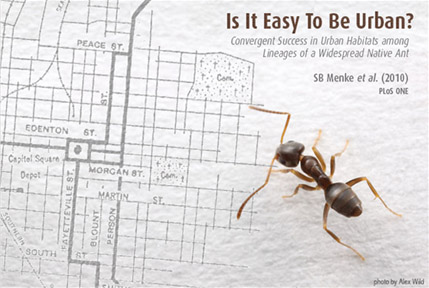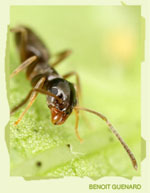Native Invaders
Ecology, behavior and taxonomy of Tapinoma sessile
Human modification to the environment in the forms of urban sprawl and agricultural practices have vastly changed habitat types and the resource landscape. The ecology of some species have altered to take advantage of these changed landscapes. These alterations in the basic biology of native species that allow them to prosper in human modified environments are often the same alterations in life history traits that allow some species to successfully invade novel regions.
My research program seeks to find generalizations that can be made in species that demonstrate a transition in life history traits between natural and urban environments using genetic, behavioral, and experimental approaches. To address these transitions in life history traits, I am studying the odorous house ant (OHA) (Tapinoma sessile), which is the most widespread native ant pest in the US. It is found in natural and urban habitats in every state and is responsible for the most repeat call backs among pest control operators. Pest populations of OHA share many life history traits in common with two of the most destructive invasive ant species, Red imported fire ant (Solenopis invicta) and the Argentine ant (Linepithema humile).
Currently I am focusing in three main areas:
1) Elucidate species level differences between populations of what are currently called T. sessile in urban and natural environments across its geographic range. PDF - Is it easy to be urban? Convergent success in urban habitats among lineages of a widespread native ant
2) Determine population level genetic structure of OHA by analyzing a) the amount and distance of gene flow within populations from urban and natural areas and b) the amount of gene flow between populations in urban and natural areas.
3) Explain the ecological mechanisms underlying the transition from small single queen colonies in natural areas to large multi-queen pest populations in urban/agricultural environments.


